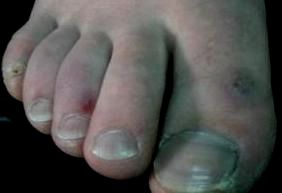Idiopathic Chilblains
Chilblains is usually an idiopathic disorder characterized by red-purple papules, patches, or plaques that develop on the extremities in non-freezing cold or damp conditions, most often on the hands and feet.

A 20-year-old woman presented in mid-winter with a mildly painful, swollen, and discolored left toe of a week’s duration. She had also noted several small pruritic lesions on the toes of both feet. Similar lesions had intermittently appeared and resolved over the previous few winter months. She denied fevers, chills, joint pain, fatigue, changes in menstruation, or other systemic symptoms. There was no history of trauma to her feet or excessive cold exposure.
The patient’s history was notable only for intermittent tinea versicolor. She used oral contraceptive pills but was not taking any other daily medications or supplements. She was allergic to erythromycin. She did not smoke cigarettes, drank alcohol occasionally, and denied any history of intravenous or other drug use. There was no family history of dermatologic or autoimmune disorders.
The patient’s vital signs were all within normal limits; her BMI was 21 kg/m2. No conjunctival or oral mucosal abnormalities were noted. Cardiac examination found no murmurs. Respiratory and abdominal examinations were unremarkable. Dorsalis pedis and posterior tibial pulses were 2+ and capillary refill was normal. The feet were mildly cool to the touch.

The patient was seen 2 times, 10 days apart. At the first visit, the left fourth toe was mildly swollen and was slightly purple. There were small violaceous macules on the ends of several toes. Ten days later, most of the swelling and purplish discoloration of the affected toe had resolved, but there was still a faintly violaceous plaque on the top of the toe. Purple macules were noted on the tip of the left third toe and on the medial aspect of the right third toe, near the nailbed (Figures). At this visit she was wearing brown leather boots with cotton socks. The complete blood count was normal. Erythrocyte sedimentation rate was 3 mm/hr. Assays were negative for antinuclear antibodies and rheumatoid factor.
The diagnosis of idiopathic chilblains (also known as perniosis) was made based on the isolated nature of her complaints, her choice of winter footwear (noted as likely to cause damp, cold feet), the absence of significant medical history, and serologic studies that found no evidence of inflammation or autoimmune disease. She was instructed to keep her feet warm and dry by avoiding cotton socks during the cold winter months.

Chilblains is usually an idiopathic disorder characterized by red-purple papules, patches, or plaques that develop on the extremities in non-freezing cold or damp conditions.1 Lesions are more commonly seen on the feet than the hands and women are disproportionately affected. Lesions usually are painful, but can burn or itch. An association with BMI less than 18 kg/m2 has been suggested.2 Digital swelling, as seen in this patient, can occur but is less common. The most effective treatment is to keep the affected area warm and dry. Oral therapy with nifedipine can be used in refractory cases to help reduce pain and facilitate healing.3
If symptoms are severe or persist into the warmer months, chilblains lupus erythematous- which is different histopathologically from idiopathic chilblains- should be considered. Patients with chilblains lupus erythematous typically have other cutaneous findings and positive serologic testing. In an otherwise healthy young person, consideration should also be given to an embolic source, such as from infectious or non-bacterial thrombotic endocarditis. In patients with other medical co-morbidities, the differential diagnosis is much more broad.4
Teaching Points:
• Idiopathic chilblains, or perniosis, is a rare inflammatory skin disorder caused by exposure to non-freezing and damp conditions.
• Typical lesions are red-purple patches, papules or plaques, most commonly affecting the feet. They are usually painful, but may itch or burn. Women are disproportionately affected.
• Early recognition can prevent unnecessary testing, though further work-up should be considered in patients in whom there is concern for an embolic cause, underlying autoimmune disease, or vasculitis.
• Treatment should focus on keeping the affected area warm and dry by modifying footwear and/or activity; persistence of symptoms into the summer months should prompt further evaluation.
Dr Turcotte is a third-year resident in primary care internal medicine in the Department of Medicine at the University of Colorado Denver, Aurora, Colorado; Dr Watson is in private practice at Gunnison Valley Family Medical Center, Gunnison, Colorado; and Dr Chacko is Associate Program Director and Primary Care Program Director, Department of Medicine, University of Colorado Denver, in Aurora, Colorado.
References:
References
1. Hirschmann JV, Raugi GJ. Blue (or purple) toe syndrome. J Am Acad Dermatol. 2009;60:1â20.
2. Prakash S, Weisman MH. Idiopathic chilblains. Am J Med. 2009;122:1152â1155.
3. Almahameed A, Pinto DS. Pernio (chilblains). Curr Treat Options Cardiovasc Med. 2008;10:128â135.
4. Brown PJ, Zirwas MJ, English JC. The purple digit: an algorithmic approach to diagnosis. Am J Clin Dermatol. 2010;11:103â116.